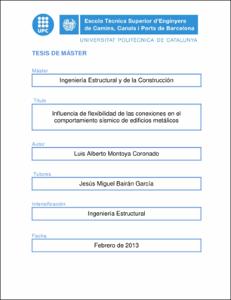Mostra el registre d'ítem simple
Influencia de flexibilidad de las conexiones en el comportamiento sísmico de edificios metálicos
| dc.contributor | Bairán García, Jesús Miguel |
| dc.contributor.author | Montoya Coronado, Luis Alberto |
| dc.date.accessioned | 2015-02-04T14:36:58Z |
| dc.date.available | 2015-02-04T14:36:58Z |
| dc.date.issued | 2013-02 |
| dc.identifier.uri | http://hdl.handle.net/2099.1/24950 |
| dc.description.abstract | [CASTELLÀ] El uso de las uniones semi-rígidas en la práctica ha ganado mucho interés en esta época ya que considerar un comportamiento semi-rígido para las uniones permite reducir las secciones de las vigas respecto a la solución rígida y articulada, al poseer rigidez rotacional suficiente a flexión el momento negativo en extremos de vano disminuye debido a la redistribución de esfuerzos. Por otro lado, al tratarse de uniones no rigidizadas, el coste de ejecución de las mismas es sensiblemente inferior al de las rígidas. No obstante las ventajas económicas de este tipo de uniones no se utilizan en la práctica del día a día en proyectos de estructuras. Hasta hace pocos años las normativas europeas sólo incluían criterios para comprobación por su resistencia, y más recientemente el Eurocódigo a través del método de las componentes permite, a partir de su geometría, determinar la rigidez y resistencia de las uniones semi-rígidas, pero es un método de análisis, no de diseño. No establece una estrategia de proceso para el diseño de pórticos con este tipo de conexiones. Un tema muy fundamental en muchos países es el comportamiento sísmico, y según estudios teóricos se puede llegar a disminuir secciones de vigas utilizando la rigidez real de esta y modificando su morfología para caer en un rango de semi-rigidez, sin embargo no se especifica nada en los reglamentos acerca de estas uniones bajo acciones sísmicas, es por ellos que se plantean los casos de los pórticos en una zona altamente sísmica. Con el fin de establecerla, y considerando que las posibles reducciones en el dimensionado de las vigas respecto a estructuras con uniones rígidas y articuladas, en la tesis se plantea analizar las posibilidades de obtener estos mismo beneficios en los resultados de diseño que ofrecen aquellas uniones no rigidizadas con un comportamiento lo más parecido posible al de las rígidas, uniones viga columna soldadas a tope y uniones atornilladas con chapa frontal extendida. Con este argumento se han calculado varios pórticos de edificación diseñados con este tipo de uniones considerando su rigidez real, obtenida mediante el método de los componentes, analizando su influencia en la respuesta de la estructura, y verificando su resistencia para diferentes longitudes de vigas y distinto número de plantas, comparando los resultados obtenidos con los de los mismos pórticos diseñados con uniones rígidas y/o articuladas. |
| dc.description.abstract | [ANGLÈS] The uses of semi-rigid joints in practice has much interest now a day, consider a semi-rigid behavior for joints can reduces sections of beams comparing to the Rigid connection and flexible connection solution, possessing a sufficient rotational stiffness negative bending moment in the ends of the beam decreases due to the redistribution of stresses. On the other hand, being unstiffened joints, the cost of carrying them is significantly lower than the flexible and rigid connection. But the economic benefits of these types of connections are not used in the practice of everyday structures projects. Few years ago European codes only included the criteria for resistance checking, and more recently through the Eurocode "the components method" allows from its geometry, to determine the real stiffness and strength of semi-rigid joints, but it is a method of analysis, not to design it. This method doesn’t establish a process to design this kind of frames with semi-rigid connections.A very important topic in many countries is the seismic behavior of structures, and as theoretical studies beam sections can decrease using their real stiffness and changing their morphology to fall within a range of semi-rigid behavior zone, currents codes doesn’t specify anything about these joints under seismic action, that’s why those cases are proposed for frames in a highly seismic zone.In order to establish, and considering that the possibility of reductions in the sizing of beams respect to structures with rigid joints and flexible joints, in this thesis aims to analyze the possibilities to have the same benefits on the results of those connections that are designed unstiffened in compared with the behavior close as possible to the rigid beam column joints butt welded and bolted joints with extended end plate. With this argument, are calculated multiple building frames designed with this type of connections considering their real stiffness, obtained by the method of components, analyzing their influence on the response of the structure, and verify their resistance to different lengths of beams and different number of floor, comparing the results obtained with frames designed with rigid connections and/or flexible connections. |
| dc.language.iso | spa |
| dc.publisher | Universitat Politècnica de Catalunya |
| dc.subject | Àrees temàtiques de la UPC::Enginyeria civil::Materials i estructures |
| dc.subject.lcsh | Seismology -- Buildings |
| dc.title | Influencia de flexibilidad de las conexiones en el comportamiento sísmico de edificios metálicos |
| dc.type | Master thesis |
| dc.subject.lemac | Sismologia -- Edificis |
| dc.subject.lemac | Unions (Construcció) |
| dc.rights.access | Open Access |
| dc.audience.educationlevel | Màster |
| dc.audience.mediator | Escola Tècnica Superior d'Enginyers de Camins, Canals i Ports de Barcelona |
| dc.audience.degree | MÀSTER UNIVERSITARI EN ENGINYERIA ESTRUCTURAL I DE LA CONSTRUCCIÓ (Pla 2009) |


